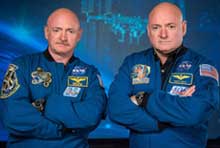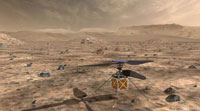April 2019 Science and Technology
Sakshi Education

- Longest spaceflight by a woman
A National Aeronautics and Space Administration (NASA) astronaut is all set to set a record for the longest spaceflight by a woman.
NASA astronaut Christina Koch is going to have her mission on the International Space Station (ISS) extended to 328 days.
This would set a record for the longest single spaceflight by a woman.
Christina Koch will remain in orbit until February 2020.
- PIO-led team's CubeSat to be launched by NASA
A team led by Keshav Raghavan has been chosen by NASA to have their CubeSat flown into space on future missions of NASA.
CubeSats are miniature satellites intended as a standard, inexpensive design that can easily fit alongside larger satellites aboard launch vehicles.
The team's CubeSat BLAST (Bouchet Low-Earth Alpha/BetaSpace Telescope) is named for physicist Edward ABouchet.
- Sri Lanka’s 1st satellite ‘Raavana-1’ launched
Sri Lanka’s first satellite ‘Raavana-1’ was launched into space from NASA’s Flight Facility on 18 April 2019.
‘Raavana 1’ weights around 1.05 kg and the lifespan of the satellite is around one and a half years.
The launch marks Sri Lanka’s entry into the global space age.
Its mission is to capture images of Sri Lanka and its neighboring countries.
- Antares launches Cygnus on ISS cargo mission
A Northrop Grumman Antares rocket successfully launched a Cygnus spacecraft on 17 April 2019 carrying 3.5 metric tons of cargo bound for the International Space Station (ISS).
The Antares lifted off from the Mid-Atlantic Regional Spaceport.
The Cygnus is scheduled to be captured by the ISS’s robotic arm.
It will remain at the station for about 90days.
- Universe’s first molecule detected in space
Scientists have detected the most ancient type of molecule in our universe in space for the first time ever.
Helium hydride ion (HeH+) was the first molecule that formed almost 14 billion years ago.
It was detected by NASA's flying observatory SOFIA towards a planetary nebula.
Helium combined first with free electrons to form the first ever neutral atom.
- Guided missile destroyer INS Imphal launched
The Indian Navy launched its third guided missile destroyer 'INS Imphal' as part of its Project 15B on 20 April 2019.
The Navy had launched INS Vishakhapatnam, the first Project 15B ship, in April 2015, while the second ship, INS Mormugao, was launched in September 2016.
The INS Imphal was designed indigenously by the Indian Navy’s Directorate of Naval Design.
- World’s first armed amphibious drone boat
China has successfully tested the world’s first armed amphibious drone boat.
It could be used in land assault operations and is capable of forming a combat triad with aerial drones and other drone ships.
The drone ship has been named Marine Lizard.
The Marine Lizard can be remotely controlled via satellites.
It can reach a maximum speed of 50 knots while maintaining stealth.
- Pakistan Navy successfully test fired missile
Pakistan Navy successfully test-fired an indigenous cruise- missile in the Arabian Sea on 23 April 2019.The indigenously developed cruise missile has anti-ship missile and land attack capability.
Vice Chief of the Naval Staff Admiral Kaleem Shaukat witnessed the live firing, which was conducted by the Navy's fast attack craft.
- Mercury has solid inner core
The smallest planet in our solar system, Mercury, has a massive solid inner core.
Mercury has a solid inner core about 2,000 kilometers in diameter, making up about half of Mercury’s entire core. The entire core is 85% of the planet.
The planet has a weak magnetic field generated by circulation of molten metal in that liquid core.
- ICRA estimated 7-7.5 GW solar power addition
Rating agency ICRA has estimated 7-7.5 GW solar power capacity addition during the current financial year, which includes 1 GW of rooftop solar power.
Solar capacity addition is estimated to have remained subdued at around 6 GW to 6.5 GW in the financial year 2018-19.
Tendered project awards for solar PV (photovoltaic) projects during CY 2018 stood at about 11 GW against 4.5 GW in CY 2017.
- Dark matter search: Xenon unstable
In a spectacular discovery, the XENON collaboration publicly announced the discovery that Xenon-124, an isotope of the element Xenon, is fundamentally unstable.
Its half-life is 1.8 × 1022 years: more than 1 trillion times the present age of the Universe.
It’s the longest half-life humanity has ever measured directly, and its implications for the nature of reality couldn’t be more profound.
- Indian Coast Guard Vessel commissioned
A new Coast Guard vessel was commissioned by Chief Secretary, Government of Kerala Sri Tom Jose at Vizhinjam harbour, on 24 April 2019.
Indian Coast Guard Ship C-441 is capable to undertake multifarious tasks such as close coast surveillance and interdiction.
The ship is commanded by Assistant Commandant Amit. K Choudhary and has 13 crew onboard with specialization in various fields.
- Microsoft topped trillion-dollar mark
Microsoft hit the trillion-dollar value mark for the first time, becoming the third technology giant to reach the symbolic milestone.
Shares in Microsoft rallied some 5% to USD 130.59 in early Wall Street trade after a robust earnings report a day earlier.
That gave Microsoft a market capitalization of just over USD 1 trillion, before dipping back slightly.
- Japan created 1st artificial crater
Japanese scientists succeeded in creating the first-ever artificial crater on an asteroid, a step towards shedding light on how the solar system evolved
The crater from images captured by the probe is located 1,700 metres (5,500 feet) from the asteroid's surface.
NASA's Deep Impact probe succeeded in creating an artificial crater on a comet in 2005, but only for observation purposes.
- Archaeologists uncovered an ancient tomb
In Egypt, archaeologists have uncovered an ancient tomb with mummies believed to date back about 2,000 years in the southern city of Aswan.
The tomb is from the Greco-Roman period, which began with Alexander the Great in 332 B.C.
Archaeologists found artifacts, including decorated masks, statuettes, vases, coffin fragments and cartonnages- chunks of linen or papyrus glued together.
- Impact of space travel on astronauts revealed
 Scientists have found no major epigenetic differences in astronaut Scott Kelly, who spent a year in space aboard the International Space Station, and his twin brother, Mark Kelly, who remained on Earth.
Scientists have found no major epigenetic differences in astronaut Scott Kelly, who spent a year in space aboard the International Space Station, and his twin brother, Mark Kelly, who remained on Earth.
Epigenetic changes involve chemical tweaks to DNA that can influence gene activity.
The changes affect when and how a gene is read, or expressed, for its protein-encoding instructions.
- New sensor can detect dangerous chemicals
Researchers at the University of Wisconsin-Madison in the US have developed a spectrometer that can be used in smartphone-sized devices to detect dangerous chemicals.
Spectrometer could be integrated with the camera of a typical cellphone. The device collects information about each individual pixel in an image to identify materials or detect specific objects.
- Tech can kill 45 million jobs in 6 years
The Advent of digital technologies will displace up to 45 million jobs by 2025.
Productivity gains through digital technologies will help create up to 65 million new jobs during the same timeframe, as per the McKinsey Global Institute report.
Retraining and redeployment will be essential to help some 10-45 million workers whose jobs could be displaced or transformed.
- Unique oil-eating bacteria discovered
At the bottom of the Mariana Trench, the deepest part of the Earth’s oceans, scientists have discovered unique oil-eating bacteria.
But the new research reveals the Mariana Trench is home to the greatest concentration of these life forms anywhere in the world.
The 2,550km long ocean trench is located in the western Pacific Ocean and reaches a maximum depth of about 11,000 metres.
- Electricity from falling snow created
Scientists have designed a first-of-its-kind 3D-printed device that can produce electricity from falling snow.
The device designed by researchers at the University of California, Los Angeles (UCLA) in the US is inexpensive, small, thin and flexible like a sheet of plastic.
The device can work in remote areas because it provides its own power and does not need batteries.
- DRDO successfully test-fired Nirbhay
India successfully test-fired its first Sub-sonic cruise missile, Nirbhay. The launch was conducted from a test range in Odisha at 11:44 am.
The missile can be deployed from multiple platforms and was launched by DRDO from complex-3 of the Integrated Test Range (ITR) at Chandipur.
The last successful trial of ‘Nirbhay’ cruise missile was conducted on November 7, 2017.
- NASA found Alien World
NASA's newest planet hunter has discovered its first Earth-size alien world.
The Transiting Exoplanet Survey Satellite (TESS) spotted the planet, as well as a weird sub-Neptune world, circling the star HD 21749, which lies about 53 light-years from Earth.
- Astronomers discovered 3rd planet
Astronomers have discovered a third planet in the Kepler-47 system, securing the system’s title as the most interesting of the binary-star worlds.
Using data from NASA’s Kepler space telescope, a team of researchers, led by astronomers at San Diego State University, detected the new Neptune- to-Saturn-size planet orbiting between two previously known planets.
- Mars based simulator unveiled in Gobi Desert
In the middle of China’s Gobi desert sits a Mars base simulator, the facility is full of teenagers on a school trip.
Surrounded by barren hills in northwestern Gansu province, Mars Base 1opened on 17 April 2019.
Its aim is to expose teens and soon tourists to what life could be like on the planet.
- SpaceX to fly its DART mission
NASA announced that SpaceX will fly its Double Asteroid Redirection Test (DART) planetary-defense mission.
The total launch cost for NASA is estimated to be about $69 million.
DART - Double Asteroid Redirection Test.
It is a planned space probe that will demonstrate the kinetic effects of crashing an impact or spacecraft into an asteroid moon for planetary defense purposes.
- Deepest radio images of sun created
Scientists have captured the deepest radio images of the Sun, an advance that may help reliably predict space weather and its possible effects on Earth.
Sun's emission can change within a second and can be very different, eve across nearby frequencies.
The Sun has some of the most powerful explosions in the solar system.
- Titan has 100 m deep methane lakes
Saturn's largest moon Titan has small liquid lakes that run more than100 metres deep, perched atop hills and filled with methane.
This was founded by scientists using data from NASA's Cassini spacecraft.
The findings are published in the journal Nature Astronomy.
They provide new information about the way liquid methane rains on, evaporates from and seeps into Titan.
- Scientists identified green material
Researchers have identified an eco-friendly solid that could replace the inefficient and polluting gases used in most refrigerators and air conditioners.
When put under pressure, plastic crystals of Neopentyl glycol yield huge cooling effects, and are competitive with conventional coolants.
The material is inexpensive, widely available and functions at close to room temperature.
- India’s first AI-enabled motorcycle
 Revolt Intellicorp will manufacture India's first AI-enabled electric motorcycle in June 2019.
Revolt Intellicorp will manufacture India's first AI-enabled electric motorcycle in June 2019.
Revolt Intellicorp has been founded by Micromax's co-founder Rahul Sharma.
The headquarters of the company is at Gurugram.
The manufacturing facility of the company is located in Manesar.
- China’s YUTU travelled on moon
China’s lunar rover Yutu-2 travelled 170.92 meters on the far side of the moon, as per the lunar exploration and space program center of the china national space administration (CNSA) on 09 April 2019.
It has run total of 163 meters during the previous three lunar day time periods.
During the third one, the rover conducted scientific examination over stones and tracks on the moon.
- SpaceX carried out first commercial launch
SpaceX has carried out its first commercial launch with its Falcon Heavy rocket tasked with placing a Saudi satellite in orbit.
The rocket exerts 5.1 million pounds of thrust -- that of more than a dozen jetliners.
- NASA’s Mars helicopter completes flight tests

NASA’s Mars Helicopter, designed to fly in thin atmosphere and low gravity, has successfully completed flight tests and is prepared for its journey to the Red Planet scheduled to take off in 2020.
Weighing in at no more than 1.8 kg, the helicopter is a technology demonstration project currently going through the rigorous verification process certifying it for Mars.
The helicopter has to function in extremely cold temperatures, including nights with temperatures as low as minus 90 degrees Celsius.
The helicopter is scheduled to reach the surface of the Red Planet in February 2021.
- ISRO successfully launches India’s latest EMISAT defence satellite
Space agency ISRO successfully launched the electronic intelligence satellite EMISAT along with 28 nano satellites of global customers from Sriharikota on 31 March 2019. With this, India seeks to give birth to a new surveillance satellite with a special mission of the Polar Satellite Launch Vehicle (PSLV C-45) that has many firsts. EMISAT and the 28 other satellites were successfully placed in the orbit, the space agency said.
Today's launch comes six days after India test-fired an anti-satellite (ASAT) missile in the Mission Shakti operation.
The countdown for the launch on the PSLV, in its 47th flight, began at 6:27 am on 31 March 2019, ISRO said. This is the 71st launch vehicle mission for Sriharikota.
Prime Minister Narendra Modi congratulated ISRO scientists for the successful launch of EMISAT.
For the first time, Indian Space Research Organization (ISRO) invited common people to view the launch.
This low-Earth orbit satellite that weighs 436 kg, sources say, will monitor and give locations for enemy radar sites deep in their territory. Till now, India was using airplanes as early warning platforms, but this satellite will give a space-based platform to sniff out enemy radars.
The mission would see ISRO placing payloads in three orbits and conducting space experiments for the first time. "The immediate mission what we are targeting is the PSLV C-45. This mission is special in the sense, for the first time PSLV will have a three-orbit mission in a single flight," said ISRO chairman K Sivan.
The PSLV launched passed through a belt of some 300 pieces of debris left behind by last week's anti-satellite (ASAT) missile launch.
EMISAT is aimed at measuring the electromagnetic spectrum, at around 17 minutes from lift off in a 749 km orbit, they would restart the fourth stage again.
The launch also carries 28 small satellites of the US, Switzerland, Lithuania and Spain. These include 20 Flock-4A satellites and 4 Lemur satellites of the same variety that gave the controversial images that questioned the efficacy of the Balakot air strikes by the Air Force.
In this mission, the last stage of the rocket will be kept alive for several weeks before it becomes space junk and it will be used as orbital platform or an orbiting space laboratory where three instruments are attached to the rocket motor. These include a maritime ship identification system, a version of a HAM Sat for amateur enthusiasts, and an experiment to study the upper atmosphere or ionosphere.
- Spider research yet to pick up pace in India, say experts
Less encouragement to study the nitty-gritty and poor awareness are hurdles; last major research conducted between 1990s, 2000s
The recent discovery of a new species of jumping spiders in Aarey Colony has had arachnologists — specialists in spiders and related animals — and wildlife expert’s call for a greater focus on studying spiders in India.
While the last major research was conducted between the 1990s and 2000s by Dr. Manju Siliwal, a senior arachnologist who specialises in mygalomorphs, experts believe a lot of diversities of spiders are yet to be discovered in the country.
They discovered a new species of jumping spiders in the city’s Aarey Milk Colony.
In the research that spanned over the next three years, researchers were able to understand the natural history of this species and explore interesting aspects that were not documented before.
Several males and females of various life stages were observed throughout the years, specifically in the monsoon, when the females were observed guarding their egg sacs, while males were seen 0wandering under the rocks.
While other species of jumping spiders such as the Langelurillus Onyx, Langelurillus Lacteus — both described in 2017 — and Piranthus decorus — recorded for the first time in 122 years in the area — have inhabited the Aarey Colony, more studies pertaining to their complete biology, habits and interactions with other species are yet to be carried out. While there are 4,800 species of spiders in the world, India alone accounts for 1,800 spider species.
While the research in other parts of the world such as Thailand, Germany, Canada and the United States has been steady, experts said it is yet to pick up pace in India.
Spiders are important creatures as they are pest-controllers. They are like the tigers of the microhabitat world. Pulling them out could cause ecological imbalance.
According to Dr. John Caleb, species of spiders other than wolf, crab, orb-weaver and ground spiders have not received enough attention in India.
Considered dangerous- People consider crawling beings as dangerous and some have phobias too. There are also certain baseless myths attached to spiders.
- One needs to understand that while studying any arthropod, animal or other being, one needs to respect their space.
- India needs at least three more spy satellites
Nobody who has it talks about it and no one else is sure about its actual numbers. But space-based electronic intelligence, the realm that India just forayed into with the launch of Monday’s defence satellite EMISAT, is said to have been around since the early 1960s.
At least three other space powers are said to be past masters at it – the U.S. as the leader is said to be having fifth-generation ELINT satellites; Russia is not far behind. And of late, China as the new space force to reckon with is believed to have two special constellations, according to the web and a few informed sources. An estimated 150 military satellites may be hovering all over Earth right now.
These satellites can locate where radars are; figure out what signals they send out in order to enable right actions; eavesdrop on radar communication; and much more.
A well-equipped satellite perched high up is an asset that can generate vast information vital for the country's defence against attacks from outside.
Coincidentally EMISAT has been flown days after DRDO achieved another publicly broadcast feat on March 27 — that of the launch of the anti-satellite missile, the ASAT.
- Groundwater system still exists on Mars: Study
Mars may still have an active groundwater system deep below the surface, and could be feeding surface streams in some areas on the Red Planet, a study has found.
In 2018, researchers detected the presence of a deep-water lake on Mars under its south polar ice caps.
Researchers at the University of Southern California (USC) in the US determined that groundwater likely exists in a broader geographical area than just the poles of Mars.
They found that there is an active system, as deep as 750 metres, from which groundwater comes to the surface through cracks in the specific craters they analysed.
Researchers studied the characteristics of Mars Recurrent Slope Linea, which are akin to dried, short streams of water that appear on some crater walls on Mars.
The scientists concluded that fractures within some of Mars’ craters, enabled water springs to rise up to the surface as a result of pressure deep below.
These springs leaked onto the surface, generating the sharp and distinct linear features found on the walls of these craters. The scientists also provide an explanation on how these water features fluctuate with seasonality on Mars.
The study, published in the journal Nature Geoscience, suggests that groundwater might be deeper than previously thought in areas where such streams are observed on Mars.
The findings suggest that the exposed part of these ground fractures associated with these springs as the primary location candidates to explore Mars’ habitability.
Previous research to explore groundwater on Mars relied on interpreting the returned electromagnetic echoes sent from the radar-probing experiments from orbit onboard Mars Express and Mars Reconnaissance Orbiter.
These experiments measured the reflection of the waves from both the surface and the subsurface whenever penetration was possible.
However, this earlier method did not yet provide evidence of groundwater occurrence beyond the 2018 South Pole detection.
- Third Edition of Bilateral Maritime Exercise between Royal Australian and Indian Navies – AUSINDEX-19 set to begin
The third edition of AUSINDEX, an acronym for Australia India Exercise is scheduled to commence with the arrival of HMAS Canberra (L02), a Landing Helicopter Dock, HMAS New Castle (06) and HMAS Paramatta (154), both frigates; HMAS Collins, a conventional submarine and HMAS Success(OR 304), a Durance-class multi-product replenishment oiler at Visakhapatnam.
The aim of the exercise is, “To strengthen and enhance mutual cooperation and interoperability between the IN and RAN, providing opportunities for interaction and exchange of professional views between the personnel of the two navies”.
A sign of strengthening of bilateral and defence cooperation between the two countries as envisaged in the Framework for Security Cooperation (FSC) announced by the Australian and Indian Prime Ministers in 2014.
The maiden edition of the exercise was held in September 2015 at Visakhapatnam. Australia hosted the second edition of the exercise off Freemantle in June 2017, wherein ships of the Eastern Fleet of the Indian Navy (IN) exercised with Royal Australian Navy (RAN) ships and submarines.
Building on a long history of cooperation – including the shared experiences in the trenches of World War I in Gallipoli and along the Western Front – Australia and India have a positive defence relationship, underpinned by the 2006 Memorandum of Defence Cooperation and 2009 Joint Declaration on Security Cooperation.
However, post the 2014 bilateral FSC the cooperation on defence and security matters between the two countries has gained significant momentum thus, witnessing conscious and focussed enhancements.
The complexity of the biennial maritime exercise over the past four years has steadily increased. The third edition would involve exercises in all three dimensions with focus on ASW.
The number of units being fielded by both navies in the bilateral exercise is the highest till date.
The increased scale of participation signifies the importance attached to the exercise by both countries while the enhanced complexity is indicative of the interoperability between the two navies.
Overall, the exercise underscores India’s vision of SAGAR (Security and Growth for All in the Region) and shared objectives of the two countries towards ensuring good order in the maritime domain and solidarity with friendly and harmonious countries.
- 4th Session of India-Ukraine working group on Trade and Economic Cooperation held in New Delhi
The 4th Meeting of India-Ukraine Working Group on Trade and Economic Cooperation (IU-WGTEC), under the India-Ukraine Inter-Governmental Commission on Trade, Economic, Scientific, Technical, Industrial and Cultural Cooperation was held on 03 April 2019 in New Delhi.
Indian delegation was led by BidyutBehari Swain, Additional Secretary, Foreign Trade (CIS), Department of Commerce, Ministry of Commerce and Industry, Government of India.
Ukrainian Side was led by Mr. OleksiyRozhkov, Director of Directorate for International Trade and Economic Cooperation and European Integration of the Ministry of Economic Development and Trade of Ukraine.
A protocol was signed at the end of the meeting. The protocol deals with review of trade, cooperation in the field of small and medium entrepreneurship, cooperation in the field of technical regulation (standardization, metrology, certification, conformity assessment), public-private partnership (PPP) and investment, agriculture, facilitating the access of Ukrainian food products to the market of India, energy sector, finance, granting Ukraine market economy status within the framework of anti-dumping investigations, and banking and cooperation in tourism.
- Study shows tiny black holes may not account for dark matter as stated by Stephen Hawking
For a whole night, the research team took 190 consecutive images of Andromeda galaxy Inter-University Centre for Astronomy and Astrophysics (IUCAA), Pune has ruled out the possibility of primordial black holes being a major constituent of dark matter. This finding disproves a theoretical claim of Prof Stephen Hawking.
Dark matter- In the solar system, Mercury, the planet closest to the Sun, takes just 88 days to make one revolution around the sun, while Neptune, the farthest one, takes 165 years to make one round.
- In like manner, laws of gravity expect us to see stars closer to the centre of galaxies rotating faster than the stars on the edge.
- However, in most galaxies, the stars closer to the centre and the stars at the edge of the galaxies take almost same time to make one revolution.
- This entity has remained as one of the central unresolved puzzles in cosmology since 1930s. It is, no wonder, named `Dark Matter’.
- The material is considered to be a ‘matter’ since it appears to have gravitational attraction and it is ‘dark’ because it does not seem to interact with light (or for that matter any part of the electromagnetic spectrum).
- Detailed surveys of the cosmos indicate that almost 85% of the total mass of the Universe is composed of dark matter.
- Thus, stars, galaxies, and atoms that we see all around are just the tip of the iceberg and the elusive dark matter makes up the bulk of the Universe.
Primordial black holes- Cosmologists have come up with various hypothesis and theories to explain the dark matter.
- Some postulate it to be composed of neutrinos, which are particles that have no charge but have tiny mass and, therefore, do not have interact with electromagnetic spectrum, but are gravitationally interacting.
- Some others have postulated they may be some new kind of elementary particles - `weakly-interacting massive particles (WIMPs)’, or `gravitationally-interacting massive particles’ (GIMPs), which are yet to be detected.
Gravitational lensing- Black holes are not radiant and will not be visible through any telescope.
- However, as first suggested by Albert Einstein, if by chance, a tiny primordial black hole eclipses a distant star, light rays of the star will bend around the black hole due to gravitational effect, resulting in the star appearing to be brighter than it originally is for a short while.
- Called `gravitational lensing’, this rare phenomena can occur only when the star, the black hole and the observer on the Earth are aligned in a straight line.
- When the black hole is in alignment with a distant star, due to gravitational attraction, light rays are bent inwards like a lens, making the star appear brighter.
Published date : 15 Apr 2019 06:11PM



















